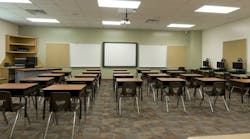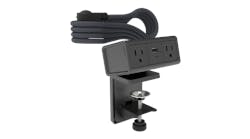Education institutions have to weigh many factors when deciding whether to install carpeting or resilient flooring in their facilities. Among the considerations are controlling allergens, chemicals and off-gassed irritants that the flooring might introduce into a facility, as well as the function of the space, the cost of the flooring, and its impact on the environment.
But regardless of the types of flooring installed, schools must be vigilant about properly maintaining carpets and flooring so they hold up to heavy use and contribute to creating an educational environment that is safe and healthful for building occupants.
The Resilient Floor Covering Institute offers these tips for helping schools keep maintain flooring so that it lasts a long time and retains a good appearance.
Routine maintenance should include wiping up spills with a damp cloth or mop as soon as possible; vacuuming, sweeping or dusting regularly to remove dirt and debris that could scratch or scuff the flooring; and spot cleaning and damp mopping flooring as needed.
Recommended preventive maintenance steps include using rubber casters or felt glides under furniture to prevent scratching of the flooring; placing mats at entrances to reduce the amount of dirt and debris tracked in; securing rugs and mats with slip-resistant backing; and selecting rugs and mats with breathable materials so that the flooring does not become discolored.
For carpets, many manufacturers use performance ratings to measure, on a scale from 1 to 5, a carpet’s ability to withstand wear. The Carpet and Rug Institute recommends that for entrances, corridors, student break areas and heavily used classrooms, schools install carpeting rated 4 or 5. For areas with less traffic—libraries, media centers, conference rooms—carpet with a rating of 3 would be suitable, the institute says. Carpeting for offices for teachers and administrators should have a rating of 2.5 or higher.
But selecting the right type of carpet is only the first step. Schools and universities must follow a thorough maintenance program to make sure they get the most out of the carpeting.
The Carpet and Rug Institute’s maintenance guidelines emphasize that a significant difference between cleaning and maintaining. Cleaning is the removal of soil; maintenance is a planned, ongoing process of soil removal.
A 2012 technical bulletin from the institute on school carpet maintenance divides school areas into severe-traffic areas (corridors, student break areas, classrooms, wipeoff areas, cafeterias and principal route passages) and heavy-traffic areas (conference rooms, teacher offices, auditoriums, teacher break areas, media centers, administrative office areas and classrooms used only part-time). In severe-traffic spaces, schools should use doormats at entrances to limit tracked-in soil; vacuum after every school day; and remove spills as soon as possible.
In heavy-traffic spaces, schools should vacuum every other day. Disposable vacuum bags should be replaced when the bag becomes half full. All dry spills should be vacuum-cleaned to lift and remove residue as soon as possible.
For liquid spills, workers should blot as soon as possible with an absorbent cloth or plain, white paper towels. The bulletin says that most spills respond to a mixture of ¼ teaspoon of clear (non-bleach, non lanolin) liquid dishwashing detergent per 1 cup of warm water. The detergent solution should be allowed to remain 8 or 10 minutes. The area should be rinsed with warm water, and blotted until an absorbent towel shows no moisture transfer.
In all areas of a school facility, extraction cleaning of carpet should take place a few days before the start of the school year and after the startup of the air-conditioning system. Another extraction cleaning should be done during the winter holiday break. The extraction should be done when the facility is unoccupied, and the ventilation system should be operating during the cleaning and for at least 48 hours after its completion.
To clean effectively, the vacuum cleaner an education institution uses must remove dirt and dust efficiently. The Carpet and Rug Institute’s Seal of Approval/Green Label program certifies vacuums that meet standards in three areas: dust containment, soil removal and carpet appearance retention.


